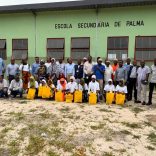Mozambique: Confirmed mpox cases have fallen to 16 - AIM report
Mozambique: A ‘hinge zone’ for understanding human evolution in prehistory

File - Research in Mozambique [Image via RFi / https://www.icarehb.com/]
Archaeological research in Mozambique is showing that the country was a “hinge zone” for prehistoric population movement between Southern Africa and East Africa.
This work is being led by archaeologist Nuno Bicho, who told RFI that he has found between “300 and 400 archaeological sites from various periods”, of which the most important were located in the Limpopo and Save valleys and near Lake Niassa.
Nuno Bicho began archaeological research in Mozambique 15 years ago. Since then, the archaeologist from the University of Algarve has found between “300 and 400 archaeological sites from various periods” in the Limpopo and Save valleys and near Lake Niassa.
“We have several archaeological sites that date back, say, to the last 100,000 years,” that is, to the Old Stone Age, explains the researcher, adding that there is a “wide range of occupations from various periods”.
Mozambique is a key element in understanding population mobility within Africa and thus better understanding the puzzle of human evolution, Bicho explains.
“Our species Homo sapiens emerged in Africa about 300,000 years ago and moved around the African continent, sometimes leaving Africa. But from a genetic standpoint, it never had obvious results, and only one departure from Africa, from East Africa, perhaps around 80,000 years ago, between 80,000 and 60,000 years ago, resulted in what we are today and spread our species throughout the world.
“What I’m currently trying to understand is how, within Africa, within the African continent, these movements occurred that allowed this group to leave Africa, around 80,000 years ago.
“We know that there are mainly two very important areas from the point of view of cultural development: one is Southern Africa and the other is East Africa. We don’t yet know the relationship between the two, and apparently, from a genetic standpoint, there seems to be information suggesting that the group that left Africa came from Southern Africa.
“Therefore, It was essential to understand what happened between the two regions. Mozambique is one of the areas with the potential to understand how this mobility, this internal migration within the African continent, and the connection between the two regions occurred.
“Mozambique is therefore a ‘pivotal area’ in the connection of populations that moved between Southern Africa and East Africa in prehistory. Now, we need to understand when and how they crossed paths.
“We will conduct a series of analyses, essentially mathematical modeling, that combine data from Southern Africa with that from East Africa and try to understand exactly when and how this transition between the two areas occurred. Mozambique, naturally, being in the middle, is undoubtedly an important element that will allow us to understand this movement and connection,” Bicho explains.
In the archaeological sites of Mozambique, materials belonging to our ancestors were found in areas where these “hunter-gatherers” engaged in daily activities.
“What we can conclude is that, largely due to the characteristics of this material culture of tools, there appears to be a marked difference between the Niassa region and the Save and Limpopo regions, meaning that there are distinct areas of cultural influence. Most likely, Niassa is linked to Tanzania and Malawi (as these regions are known politically today), while the Save and Limpopo regions are more closely related to Southern Africa. We know this.
“We know that they used a wide range of animal species; we don’t know which ones yet, but we will know in the future through various analyses.
“We know that they used a range of other species, particularly aquatic species, because we have a wide range of shells from various species at some of the archaeological sites. We also know that they used ostrich eggshells primarily for decorative purposes, making beads for necklaces and so on.”
Three years ago, the European Research Council awarded a five-year grant to the archaeologist, who promises to continue his research and seek funding to continue his research.
Nuno Bicho has been working in the field with archaeology students at Eduardo Mondlane University.
Some artefacts are processed in the laboratories of the Department of Anthropology and Archaeology at this Mozambican university, but others are sent to Portugal for analysis before being returned to Eduardo Mondlane University.
For now, it’s not possible to do everything in Mozambique.
“There’s no financial capacity to invest in archaeology, particularly in the Stone Age. That’s one aspect. And second, training is still limited at Eduardo Mondlane University, which is the only university that offers archaeology. Although they offer a bachelor’s degree and many students graduate every year, fortunately – because this promotes the study of archaeological heritage and enables a very relevant defence – they don’t offer advanced training after graduation.
:Other countries, like Portugal – the University of Algarve – are enabling this development. Currently, there are about half a dozen PHDs in archaeology in Mozambique. Fifteen years ago, when I started, there was only one person. This work is very important. And it wasn’t just the University of Algarve that does this; there are also universities in Sweden that promote this type of work. There are several PhDs obtained in Sweden,” Bicho says.
Bicho was also researching the same period of human evolution in Sudan, but that research has for now been interrupted by war in the region.












Leave a Reply
Be the First to Comment!
You must be logged in to post a comment.
You must be logged in to post a comment.